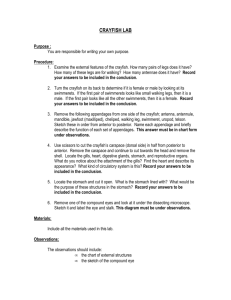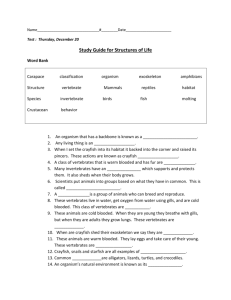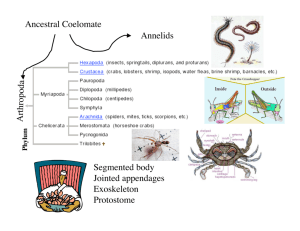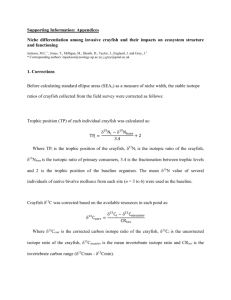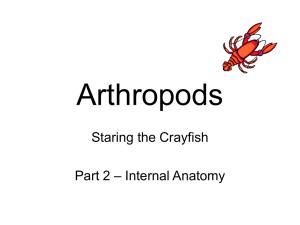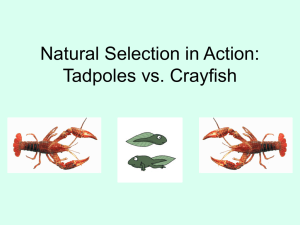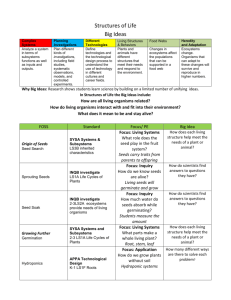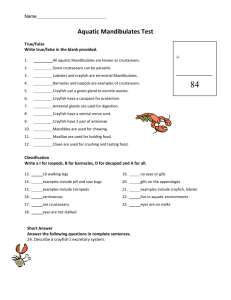SP06 crayfish lab 2 - local.brookings.k12.sd.us
advertisement
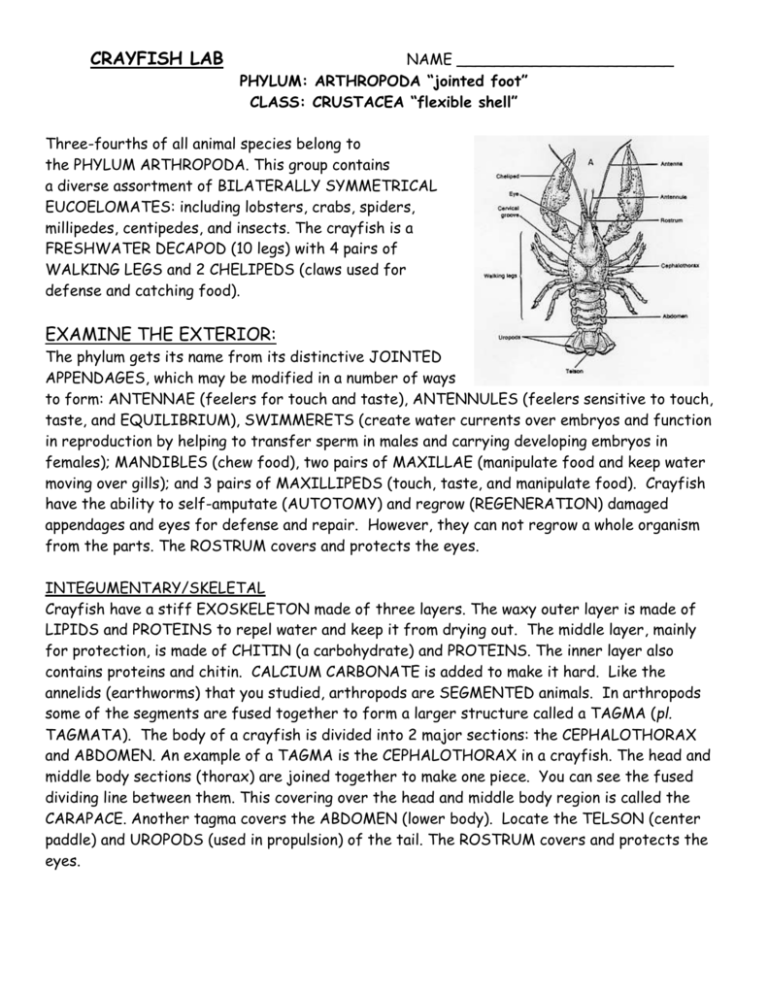
CRAYFISH LAB NAME _______________________ PHYLUM: ARTHROPODA “jointed foot” CLASS: CRUSTACEA “flexible shell” Three-fourths of all animal species belong to the PHYLUM ARTHROPODA. This group contains a diverse assortment of BILATERALLY SYMMETRICAL EUCOELOMATES: including lobsters, crabs, spiders, millipedes, centipedes, and insects. The crayfish is a FRESHWATER DECAPOD (10 legs) with 4 pairs of WALKING LEGS and 2 CHELIPEDS (claws used for defense and catching food). EXAMINE THE EXTERIOR: The phylum gets its name from its distinctive JOINTED APPENDAGES, which may be modified in a number of ways to form: ANTENNAE (feelers for touch and taste), ANTENNULES (feelers sensitive to touch, taste, and EQUILIBRIUM), SWIMMERETS (create water currents over embryos and function in reproduction by helping to transfer sperm in males and carrying developing embryos in females); MANDIBLES (chew food), two pairs of MAXILLAE (manipulate food and keep water moving over gills); and 3 pairs of MAXILLIPEDS (touch, taste, and manipulate food). Crayfish have the ability to self-amputate (AUTOTOMY) and regrow (REGENERATION) damaged appendages and eyes for defense and repair. However, they can not regrow a whole organism from the parts. The ROSTRUM covers and protects the eyes. INTEGUMENTARY/SKELETAL Crayfish have a stiff EXOSKELETON made of three layers. The waxy outer layer is made of LIPIDS and PROTEINS to repel water and keep it from drying out. The middle layer, mainly for protection, is made of CHITIN (a carbohydrate) and PROTEINS. The inner layer also contains proteins and chitin. CALCIUM CARBONATE is added to make it hard. Like the annelids (earthworms) that you studied, arthropods are SEGMENTED animals. In arthropods some of the segments are fused together to form a larger structure called a TAGMA (pl. TAGMATA). The body of a crayfish is divided into 2 major sections: the CEPHALOTHORAX and ABDOMEN. An example of a TAGMA is the CEPHALOTHORAX in a crayfish. The head and middle body sections (thorax) are joined together to make one piece. You can see the fused dividing line between them. This covering over the head and middle body region is called the CARAPACE. Another tagma covers the ABDOMEN (lower body). Locate the TELSON (center paddle) and UROPODS (used in propulsion) of the tail. The ROSTRUM covers and protects the eyes. ENDOCRINE SYSTEM The endocrine glands release hormones into the blood which control other body functions, such as molting, sexual development, and regulation of heart rate. MUSCULAR MUSCLES attach to the inside of the exoskeleton on either side of the joints, move the body segments. Powerful MUSCLES in the abdomen can bend the abdomen suddenly (called a tailflip) propelling the animal backwards. Crayfish also use their walking legs to get around. Strong ADDUCTOR muscles attach to the EXOSKELETON and operate the mouthparts. RESPIRATORY Remove the CARAPACE to see the gills underneath. Crayfish have GILLS for exchange of gases. The gills attach at the base of the WALKING LEGS and extend into a cavity under the CARAPACE and are separated from the body by an internal divider. As a crayfish walks, the WALKING LEGS circulate water across its gills. The posterior pair of MAXILLAE called “BAILERS”, also help in respiration by keeping water moving over the gills. DIGESTIVE Crayfish are scavengers. They eat just about anything… dead or alive. CHELIPEDS are used to capture food. The MAXILLA and MAXILLIPEDS help move the food to the MOUTH. Food is chewed with its MANDIBLES. Food passes through the ESOPHAGUS into the 2-part STOMACH (CARDIAC & PYLORIC) where the GASTRIC MILL (teeth made of CHITIN and CALCIUM CARBONATE) grinds it into a find paste. Enzymes from the DIGESTIVE GLAND (simple liver) near the stomach are mixed with the food, which enters the digestive gland and intestine for further digestion and absorption. Indigestible waste leaves the body through the ANUS near the TELSON. CIRCULATORY Crayfish have an OPEN circulatory system. Hemolymph leaves the DORSAL HEART in large VESSELS (ARTERIES) which carry it to different parts of the body, but there are NO RETURNING VESSELS (VEINS). The blood leaves the vessels and enters the HEMOCOEL (BODY CAVITY) where it bathes the tissues. It passes through the gills where it exchanges oxygen and carbon dioxide with the water. From there it returns to the dorsal part of the crayfish and reenters the heart through openings called OSTIA (sing. OSTIUM). EXCRETORY Since plenty of water is available, crayfish can excrete their nitrogen waste in the most toxic form as AMMONIA. It is released through the GILLS and also GREEN GLANDS which also regulate water and ion concentration. These glands are green in fresh specimens, but are usually yellow in preserved specimens. Because crayfish live in freshwater (a HYPOTONIC environment), water is constantly entering the tissues. The green glands collect ammonia and excess water and excrete it through pores at the base of the ANTENNAE. NERVOUS The nervous system of a crayfish is similar to that seen in earthworms. The crayfish’s brain is a pair of CEREBRAL GANGLIA above the ESOPHAGUS that receives impulses from the eyes, antennules, and antennae. Two bundles of nerve fibers extend from the brain around the esophagus on either side to a GANGLION that controls the mouth parts. A VENTRAL NERVE CORD runs along the body connecting to multiple GANGLIA along body that control the appendages and muscles in the abdomen and thorax. Crayfish have COMPOUND EYES set on short stalks. Each eye has over 2000 light-sensitive units each with its own lens. The ANTENNAE and ANTENNULES are sensitive to TASTE and TOUCH. The ANTENNULES also detect changes in EQUILIBRIUM. Crayfish can sense vibrations and chemicals in the water with thousands of small sensory hairs that project from their exoskeleton. REPRODUCTION Crayfish have SEPARATE SEXES. They are either MALES with a TESTES for making sperm or FEMALES with an ovary for making eggs. The GONADS (reproductive organs) are located underneath the heart. In females you will see the ovaries with eggs inside and in males you will see the tiny tubules for carrying sperm (VAS DEFERENS). In males the 1st two pairs of SWIMMMERETS are modified to transfer sperm to the female. Females store sperm in a SEMINAL RECEPTACLE (opening between the back walking legs) until the eggs are released. Fertilization in crayfish is EXTERNAL. The embryos are carried on the female’s SWIMMERETS until they mature. Most arthropods have INDIRECT DEVELOPMENT. They start life as a free swimming NAUPLIUS larva with 3 pairs of appendages and a single eye in the middle of its body. Name NAME ___________________________ CRAYFISH LAB QUESTIONS LATIN MEANING: KINGDOM ____________________ PHYLUM _____________________ __________________________ CLASS: ______________________ __________________________ 1. Give an EXAMPLE of a TAGMA (two body sections fused to make one) seen in crayfish. _________________________ 2. How you can tell a male crayfish from a female by looking at the OUTSIDE of your crayfish? MALES_______________________________________________________ FEMALES_____________________________________________________ 3. How is the skeleton of a crayfish different than that in a starfish? (Remember to describe BOTH) Starfish _______________________________________________ Crayfish _______________________________________________ 4. What 4 substances makeup the exoskeleton of a crayfish? ___________________ ____________________ ____________________ ____________________ 5. Tell 2 ways the CIRCULATORY system in a crayfish is SIMILAR to that in an earthworm. _______________________________________________________ _______________________________________________________ 6. How can a crayfish have an OPEN circulatory system if it has ARTERIES leaving the heart? ___________________________________________________________ 7. The hemolymph (blood) returns to the heart through openings called______________ 8. How do the swimmerets help in reproduction? In males _______________________________________________ In females _____________________________________________ 9. The stomach of a crayfish has 2 parts like that of a starfish. Name them. _______________________ ______________________ 10. Where are the teeth in a crayfish? ____________________ 11. What are some body functions that the ENDOCRINE body system controls? ____________________________________________________________________ 12. Which form of nitrogen waste is excreted by crayfish? ____________________ 13. The nervous system of a crayfish is most like that of a(n) __________________________ Earthworm clam starfish because both have _______________________________ 14. What is AUTOTOMY and how does it help the crayfish? ___________________________________________________________ 15. Complete the sentences below using words from the word bank: DORSAL VENTRAL Invertebrates have a _____________ heart and a ____________ nerve cord. Vertebrates have a _____________ heart and a _____________ nerve cord. CRAYFISH STARFISH Sexual/ Asexual Fertilization? (internal/external) Development (direct/indirect) Type of larva Fill in the following chart: APPENDAGE Antennule Antenna Mandible Maxilla Maxilliped Cheliped Swimmeret FUNCTION CLAM COMPARE ANTENNA ANTENNULES SIZE What can it sense? CIRCLE ALL THAT APPLY TO CRAYFISH: Acoelom Pseudocoelom Invertebrate protostomes Eucoelom Invertebrate deuterostomes blastopore mouth (Determinate spiral cleavage) blastopore anus (indeterminate radial cleavage) External fertilization Internal fertilization Indirect Development Direct development HERMAPHRODITE SEPARATE MALE and FEMALE SEXES Asexual Reproduction Sexual Reproduction Open circulation Closed circulation No cephalization Cephalization VENTRAL nerve cord/DORSAL heart Asymmetry Vertebrate deuterostomes DORSAL nerve cord/VENTRAL heart Radial symmetry Bilateral symmetry NAME THE BODY PART: Removes nitrogen waste ___________________ & ________________________ Osmoregulation (maintains water/ion balance) _____________________ Makes bile _____________________________________ Work together to complete digestion and absorb nutrients _________________________ & ______________________________ Collects and concentrates digestive waste ______________________ Exit opening for digestive waste ____________________ Acts as “brain” ____________________________ Pumps hemolymph __________________ Vessels that carry blood away from the heart _________________________ Openings for blood to re-enter heart __________________ Visor to cover and protect eyes __________________ Exchange gases with water ____________________ Carries nerve signals from “brain” to body ______________________________ Makes eggs ____________________ Makes sperm ______________________ In females this stores sperm received from males __________________________ Tubules for carrying sperm from testes out of body _________________________ Controls molting, heart rate, and sexual development ____________________ system Keep water moving over gills ______________________ & ______________________ Part of exoskeleton that covers and protects gills ___________________________ Part of stomach closest to mouth _________________________ Part of stomach that connects to intestine ____________________________ Teeth in the stomach of a crayfish __________________________ Center tail section ________________________ Side tail sections ____________________________
